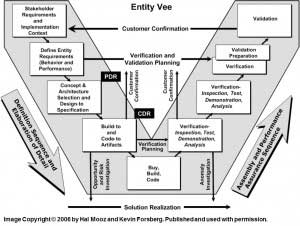
Development of the V-Modell occurred over a 4-year period beginning in 1986. Pilot project trials started in early 1990. It was made obligatory for the defense area by the Federal Ministry of Defence in February 1991. The V-Modell proved so successful in Germany’s defense industry that in the summer of 1992 it was taken over by the Federal Ministry of the Interior for the civilian public authorities domain to provide a uniform systems development standard for the whole range of public authorities. With the publication of the “Development Standards for IT Systems of the Federal Republic of Germany” in 1997, the V-Modell 97 entered into force as the standard for all civil and military federal agencies. It was used throughout Germany by banks, insurance companies, car manufacturers, the manufacturing industry and energy producers.
The V-Modell gained traction in Europe. An English translation was completed for use in international projects. It is the subject of a European Commission (EC) project started in 1989 with the goal of surveying software engineering methods and harmonizing them. The German representative to the EC Committee is the Federal Ministry of the Interior. In view of the Ministry’s own use of the V-Modell, it was nominated as the German standardization contribution at the European level.
The German V-Modell was structured into four functional parts called submodels. The submodels are:
- Software Development (SWD)
- Quality Assurance (QA)
- Configuration Management (CM)
- Project Management (PM)
These four are closely interrelated and mutually influence one another through the exchange of products/results. Since the focus of our SDLC is systems development, let’s decompose the software development submodel. The submodel comprises the following nine primary activities:
- System Requirements Analysis and Design:
- Describes the system requirements its environment
- Conduct a threat and risk analysis; develop a security concept
- Deliver a user level model of functions/data/ objects
- Structure the system into subsystems, segments or configuration items
- DP Requirements Analysis and Design
- Describe the DP segment requirements and its environment
- Development of a security model, structuring the segment into its SW and HW configuration items
- SW Requirements Analysis
- Describe the SWCI requirements and its environment
- Preliminary Design
- Structure the SWCI in SW components/modules/database, specification of the interfaces and interaction of its elements
- Detailed Design
- Describe the components and modules with respect to the real implementation of their functions, the data administration and error handling up to a programmig specification
- Implementation
- Convert the programming specifications to statements of the programming language
- Perform informal assessment of developed code and implementation of a database (if required)
- SW Integration
- Integrate modules to components and components to the SWCI
- DV Integration
- Integrate the different SW and HW configuration items to a DP segment
- System Integration
- Integrate the subsystems (if existing) and segments to the system
V-Modell 97 met with obsolescence in 2004. It no longer reflected the state-of-the-art of information technology and its use declined. New methods and technologies—as for example component-based development or the test-first approach—are considered only to a limited degree in V-Modell 97. It is superseded by “V-Modell XT,” completed in 2006. The V-Modell XT is a standard developed on behalf of the Federal Office of the Bundeswehr for Information Management and Information Technology and the Federal Ministry of the Interior, Central Office for Information Technology Coordination in the Federal Administration (BMI-KBSt).


I love understanding the history of how things came to be so this is perfectly down my street.
Thanks for sharing
David
PS Have you updated or extended this write-up since it was published?